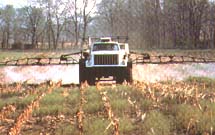Technological improvements have reduced the impact of pesticides on the aquatic environment

The chemical, physical and biological properties which determine
the effect of pesticides on water resources and the fate of these
pesticides in the environment have been advanced significantly in
the years since Rachel Carson's
Silent Spring. Wide spectrum
pesticides, which kill a wide variety of non-target organisms and
remain active for a long period time, are no longer used. For
example, DDT is a wide spectrum chlorinated hydrocarbon with a
half life of ten years (i.e. the time required for one half of a
compound to decay). DDT, and other pesticides like it, have been
banned in the United States because they concentrate in the fatty
tissue and tend to accumulate in the food chain where they can
interfere with the reproduction and survival of many non-target
species.
Many complementary insecticides such as Organophosphate and
Carbamate have half lives of only a few days to several weeks,
are not fat soluble, and are often much more specific in the
targets they affect. While these insecticides do not accumulate
up the food chain and are safer environmentally, they are very
soluble in water and usually quite toxic to fish.
In contrast, most herbicides currently in use break down by the
end of the growing season and are relatively less toxic to fish
than insecticides. However, if herbicides reach surface waters,
many species of aquatic plants can be killed. Along with shorter
half lives, newer pesticides utilize more effective stickers (the
chemical which keeps them in place) and are thus effective in
much lower concentrations. This makes them easier to control and
adds less chemical to the environment. In addition, biological
controls (viruses and bacteria that occur in nature) are being
refined and adopted for use as natural microbial pesticides, such
as Bacillus thuringiensis for the control of gypsy moth.